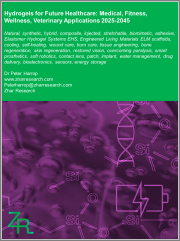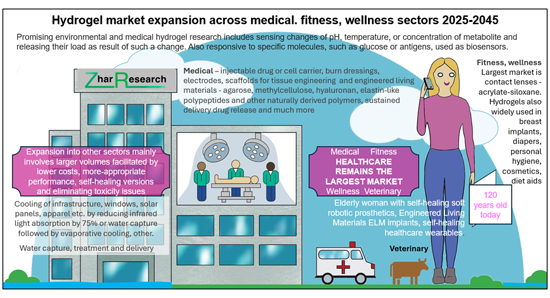
|
시장보고서
상품코드
1745942
미래 의료를 위한 하이드로겔 : 의료, 피트니스, 웰니스, 수의학 응용 분야(2025-2045년)Hydrogels for Future Healthcare: Medical, Fitness, Wellness, Veterinary Applications 2025-2045 |
||||||
장수와 삶의 질
우리의 많은 손주들은 120세까지 살 수 있고, 하이드로겔의 놀라운 발전으로 인해 훨씬 더 나은 삶을 누릴 수 있게 될지도 모릅니다.
두 가지 병행하는 트렌드
보고서의 저자인 Peter Harrop 박사는 "두 가지 병행되는 트렌드가 헬스케어용 하이드로겔 시장을 2025년 370억 달러에서 2045년 1,540억 달러로 강력하게 성장시키는 원동력이 될 것입니다."라고 말했습니다. 패드, 기저귀, 콘택트렌즈와 같은 성숙한 제품이 신흥국에 보급될 것입니다. 반면 선진국에서는 마비된 사람이 움직일 수 있게 되고, 시각장애인이 시력을 되찾고, 기능부전 장기를 대체하는 등 혁신적인 진보가 적극적으로 도입될 것입니다. 이를 위해 복합재료, 천연/합성 하이브리드, 범용 하이드로겔 등 새로운 무기 하이드로겔이 빠르게 등장하고 있습니다. 향후에는 수술에 사용되는 엔지니어링 구동 재료용 하이드로겔 비계 재료까지 등장할 것으로 예측됩니다."

세계의 헬스케어용 하이드로겔(Hydrogel) 시장을 조사했으며, 시장 개요, 배경, 의료 및 비의료 분야에서의 용도, 최신 연구 동향, 시장 규모 예측, 전문가 인터뷰, 사업 기회, 잠재적 파트너, 경쟁사 등의 분석 정보를 정리하여 전해드립니다.
목차
제1장 주요 요약·결론
제2장 서론
- 배경
- 2025년에 진보하는 헬스케어 하이드로겔 처방
- 겔이라는 말에 관한 주석
- 제한사항
- 천연 vs. 합성
- 하이드로겔의 독성 물질이 문제가 되는 이유
- 의료 분야에서의 하이드로겔 진전과 응용 사례 23건
- 의료 이외 6개 분야에서의 헬스케어 관련 하이드로겔 응용 사례 19건
- 창상 치유의 진전
- 하이드로겔 제조 기술의 진화(3D/4D 프린팅 포함)
제3장 헬스케어를 위한 하이드로겔 툴 키트
- 개요
- 하이드로겔의 SWOT 평가 : 현재 위치
- 하이드로겔 시장 확대 상황을 나타내는 도표
- 하이드로겔 분자 레벨 툴 키트와 동향
- 새롭게 등장하는 6개 유형의 하이드로겔 화학 및 기능성 패밀리
- 6개 분야에서 하이드로겔의 미래를 지원하는 기술 카테고리
- 실리콘 및 폴리우레탄 하이드로겔과의 경쟁과 통합 가능성
- 최신 연구에서 기타 신흥 재료는 하이드로겔과 어떻게 경쟁 하고 있는가?
- 하이드로겔 개량의 가장 유망한 방향성
- 엘라스토머 하이드로겔 시스템(EHS)
- 하이브리드형 하이드로겔
- 인포메이션 그래픽 자가치유형 하이드로겔과 SWOT 평가
제4장 미래의 하이드로겔 : 냉각, 의약품, 의지, 치료 용도, 기타
- 개요
- 인포그램 : 새로운 냉각 및 열 관리 요구
- 5개의 인포그래픽 : 냉각 툴 키트와 하이드로겔의 기회
- 하이드로겔에 의한 증발 냉각
- 미래형 하이드로겔 기술로 의료 전자기기, 6G 통신 및 태양광 패널을 냉각하는 방법
- 유용수 회수를 포함한 태양전지판 하이드로겔 냉각
- 건축 냉각 분야의 독창적인 새로운 하이드로겔
- 에어로겔과 하이드로겔 편성에 의한 의약품 냉각
- 소프트 로보틱스, 의지용 자기 냉각 스마트 액추에이터
- 헬스케어 과제에 관련된 기타 냉각 하이드로겔
제5장 자가치유 기능을 포함한 미래의 헬스케어 하이드로겔 실용화
- 정의와 초점
- 자기 치유 기본
- 엔지니어링 및 의료 분야에서 자가치유 하이드로겔의 중요성
- 자가치유 재료의 SWOT 평가
- 자가치유 하이드로겔 기술 옵션
- 실제 및 잠재적인 자가치유 용도 대체품에 대한 하이드로겔의 경쟁력
- 2025-2045년 연구 파이프라인에서의 중요 사례
제6장 향후 하이드로겔 멤브레인, 피부, 필름 : 이온 교환, 가스 분리, 기타
- 개요
- 멤브레인 난이도 및 자가치유 필요성
- 최근 연구에서의 자가치유 멤브레인 화학
- 기초
- 건축용 및 음향용 메브레인
- 배터리, 슈퍼커패시터, 연료전지 세퍼레이터, 전해질막
- 인간과 로봇을 위한 e스킨
- 가스 분리
- 이온 전도체
- 한외여과막
제7장 향후의 하이드로겔 플렉서블 일렉트로닉스, 센서, 고체 에너지 저장
- 개요
- 플렉서블 및 고체 에너지 저장 예
- 바이오테크놀러지 및 환경 용도 자기 반응형 하이드로겔
- 센서와 센싱
- 트랜지스터
- 전자기기용 열 하이드로겔
제8장 하이드로젤을 사용하거나 하이드로젤과 경쟁하는 엔지니어링 생활 소재 ELM
- 개요
- 자연에서 배우기
- 대표적인 특징과 소재
- 분류법
- 장애물과 앞으로 나아갈 길
- ELM 연구에서의 생체 재료 사례
제9장 헬스케어 인프라와 물관리 향후 하이드로겔 재료
- 개요
- 콘크리트 및 기타 시멘트질 재료
- 하이드로겔을 사용한 안전한 식수
- 공기로부터 유용한 물을 추출하는 하이드로겔과 대체품
- 재이용 가능한 하이드로겔에 의한 귀금속 회수
Summary
Longevity, quality of life
Many of our grandchildren may live to 120 years and have a far better quality of life due to latest heroic achievements with hydrogels. A unique new Zhar Research report looks deeply into latest 2025 research and its interviews with PhD level analysis and forecasting, revealing your opportunities, potential partners and competition for both the materials and devices emerging. It is commercially oriented, 320-page, "Hydrogels for Future Healthcare: Medical, Fitness, Wellness, Veterinary Applications 2025-2045".
Two parallel trends
Primary author, Dr Peter Harrop says, "Two parallel trends drive robust growth of the healthcare hydrogel market from $37 billion in 2025 to $154 billion in 2045. The mature products such as pads, diapers and contact lenses will be adopted by emerging countries. Advanced countries will eagerly adopt new advances enabling the paralysed to function, the blind to see, failed organs to be replaced and much more. New inanimate hydrogels are rapidly arriving to achieve this, including composites, hybrid natural/ synthetic and multipurpose hydrogels but later years will even see hydrogel scaffolds for Engineered Living Materials employed in surgery."
Complete summary
The Executive Summary and Conclusions (36-pages) is enough for those in a hurry, for here are the 16 primary conclusions, the emerging technologies and market dynamics in detailed new infograms, 21 forecast lines and roadmap 2025-2045. See problems that are your opportunities such as replacing toxigen intermediaries.
Deep analysis for materials and hardware suppliers
The Introduction (22 pages) briefly gives the long history and companies involved today then more detail on the many benefits, market drivers and formulations for healthcare hydrogels with advances in 2025. What are currently the popular choices and why is the biomimetic approach very useful? Why should we be beware of the term gel and recognise many toxigen and performance limitations of current hydrogels? See 23 examples of medical hydrogel advances and applications and 19 examples of other healthcare-related hydrogel applications in six sectors beyond medical. Other topics introduced are natural vs synthetic, wound healing advances in 2025 and evolving production technologies for hydrogels including 3D and 4D printing in 2025.
Comprehensive toolkit emerging with examples of medical achievements
Chapter 3. Hydrogel Toolkit for Healthcare 2025-2045 (30 detailed pages) to explain all this in detail including six families of hydrogel chemistry and functionality and subsets such as Elastomer Hydrogel Systems EHS. Commercial emphasis is enhanced by some latest research advances in wound healing, sensorised and rejuvenated skin, easing Crohn's disease, and restoring vision, with Zhar Research analysis.
Healthcare cooling hydrogels
Chapter 4. Future Hydrogels that Cool: Pharmaceutical, Prosthetic, Therapeutic, other (33 pages) appraises this commercially important aspect. Six infograms display major new cooling and thermal management needs arriving 2025-2045, the cooling toolkit and the hydrogel opportunity. Understand hydrogel evaporative cooling in general with ambitions, limitations. What about future hydrogel technologies, even cooling of healthcare electronics, use of hydrogel-silica aerogel, thermogalvanic hydrogel for synchronous evaporative cooling and latest 2025 research advances? Healthcare facilities may employ hydrogel windows to block and store heat, use aerogel and hydrogel together cool pharmaceuticals. Expect self-cooling smart actuators for soft robotics and prosthetics and learn other cooling hydrogels relevant to healthcare challenges 2025-2045.
Healthcare self-healing hydrogels and more
Chapter 5. Future Healthcare Hydrogels in Action, Including Self-healing Function, with 81 pages, looks more generally at the future applications, mostly revealing the great importance of self-healing hydrogels. Understand the science of intrinsic and extrinsic self-healing and the value chain. See types of damage addressed with examples such as skin, bone regeneration, wound healing, cancer therapy and drug delivery with hydrogels, including injectables, but the dilemma of metrics for self-healing and the benefits of alternatives. A SWOT appraisal is followed by important examples in the research pipeline for 2025-2045. Self-healing healthcare electronics, sensors and nanogenerators for smart patches and implants is covered. Then comes research success with spinal cord implants for treating paralysis, soft robotics, smart prosthetics, bioelectronics and cartilage, stretchable hydrogels for protein delivery, tissue engineering, adding the impact of adhesive and self-lubricating hydrogels.
Membrane, skin, film, ELM hydrogels emerging
Chapter 6. Future Hydrogel Membranes, Skin and Film: Ion-exchange, Gas separation, Other (19 pages) expands on these aspects with detailed tabular comparisons and many research advances from 2025. Zhar Research finds that almost all the market potential for healthcare hydrogels will involve inanimate forms, increasingly synthetic for tailoring to purpose but Engineered Living Material may get commercialised late in the 2025-2045 timeframe with hydrogels favourite as scaffolds on which the living material is grown for therapy on and later in humans but in competition with entirely inanimate hydrogel solutions to the same challenges. All that is covered in Chapter 8. Engineered Living Materials ELM Using or Competing with Hydrogels (29 pages). However, understand why the level of research is not increasing. The report then ends with the more peripheral topic in Chapter 9. Future Hydrogel Materials in Healthcare Infrastructure and Water Management with companies, technologies and progress involved. In the whole report, 59 companies are mentioned.
Essential reading
The latest information and in-depth analysis is essential to aid your participation in commercial healthcare hydrogels. The report, "Hydrogels for Future Healthcare: Medical, Fitness, Wellness, Veterinary Applications 2025-2045" is your essential source.
CAPTION: Hydrogel market expansion across medical. fitness, wellness sectors 2025-2045. Source, Zhar Research report, "Hydrogels for Future Healthcare: Medical, Fitness, Wellness, Veterinary Applications 2025-2045".

Table of Contents
1. Executive summary and conclusions
- 1.1. Purpose and layout of this report
- 1.2. Methodology
- 1.3. Infogram: hydrogel market expansion across medical. fitness, wellness sectors 2025-2045
- 1.4. Definitions, needs and context
- 1.5. Sixteen primary conclusions
- 1.6. How hydrogel toxigens are an issue and an opportunity
- 1.7. Hydrogel technology choices, examples, trends
- 1.8. Analysis of recent research advances by material type
- 1.9. Hydrogel SWOT appraisal
- 1.10. Hydrogel roadmap 2025-2045 by industry sector
- 1.11. Market forecasts 2025-2045 in 21 lines
- 1.11.1. Healthcare hydrogel devices vs hydrogel materials market $ billion 2025-2045
- 1.11.2. Global market for hydrogel materials: 3 sectors and total $ billion 2025-2045
- 1.11.3. Four regions percentage of healthcare hydrogel material value market 2025-2045
- 1.11.4. Synthetic vs natural vs hybrid % of healthcare hydrogel material value market 2025-2045
- 1.11.5. Hydrogel enabling technology added by 5 functional categories $ billion 2025-2045
- 1.11.6. Global healthcare expenditure vs healthcare hydrogel device market $ billion 2025-2045
- 1.11.7. Solid-state cooling module market $ billion 2025-2045
2. Introduction
- 2.1. Background
- 2.1.1. Long history and companies involved today
- 2.1.2. Many benefits
- 2.1.3. Market drivers
- 2.1.4. Contact lenses
- 2.2. Formulations for healthcare hydrogels with advances in 2025
- 2.2.1. Popular choices
- 2.2.2. Biomimetic approach is very useful: 2025 and earlier
- 2.3. Beware of the term gel
- 2.4. Limitations
- 2.5. Natural vs synthetic
- 2.6. How hydrogel toxigens are an issue
- 2.7. 23 examples of medical hydrogel advances and applications
- 2.8. 19 examples of other healthcare-related hydrogel applications in six sectors beyond medical
- 2.9. Wound healing advances in 2025
- 2.10. Evolving production technologies for hydrogels including 3D and 4D printing in 2025
3. Hydrogel toolkit for healthcare 2025-2045
- 3.1. Overview
- 3.2. Hydrogel SWOT appraisal - where we are now
- 3.3. Graphic of hydrogel market expansion across the landscape 2025-2045
- 3.4. Hydrogel molecular toolkit and trends
- 3.6. Six families of emerging hydrogel chemistry and functionality
- 3.7. Future hydrogel enabling technology by six other categories covered in later chapters
- 3.8. How silicones and polyurethanes will both compete with and combine with hydrogels
- 3.9. How other emerging materials compete with hydrogels in latest research
- 3.10. Most promising routes to improvement of hydrogels 2025-2045
- 3.10.1. Biomimetic, composite and chemistry
- 3.10.2. Appraisal of important new medical research: wound healing, sensorised and rejuvenated skin, easing Crohn's disease, restoring vision etc.
- 3.11. Elastomer Hydrogel Systems EHS
- 3.11.1. Basics
- 3.11.2. Directly bonded or interphase
- 3.11.13. Earlier work advancing multifunction and other elastomer hydrogels
- 3.12. Hybrid hydrogels
- 3.13. Self-healing hydrogels with infograms and SWOT appraisal
4. Future hydrogels that cool, pharmaceuticals, prosthetic, therapeutics, other
- 4.1. Overview
- 4.2. Infogram: Major new cooling and thermal management needs arrive 2025-2045
- 4.3. Five infograms: The cooling toolkit and the hydrogel opportunity
- 4.4. Hydrogel evaporative cooling in general
- 4.4.1. Ambitions, limitations
- 4.4.3. Hydrogel open evaporative cooling
- 4.5. Future hydrogel technologies cooling of healthcare electronics, 6G telecommunications and solar panels
- 4.5.1. Hydrogel-silica aerogel
- 4.5.2. Thermogalvanic hydrogel for synchronous evaporative cooling
- 4.6. Hydrogel cooling of solar panels including gathering useful water
- 4.7. Imaginative new hydrogels in architectural cooling
- 4.7.1. Hydroceramic hydrogel cooling architectural structure
- 4.7.2. Hydrogel windows to block and store heat
- 4.8. Aerogel and hydrogel together cool pharmaceuticals etc.
- 4.9. Self-cooling smart actuator for soft robotics, prosthetics
- 4.10. Other cooling hydrogels relevant to healthcare challenges 2025-2045
5. Future healthcare hydrogels in action, including self-healing function
- 5.1. Definitions and focus
- 5.2. Self-healing basics
- 5.2.1. Self- healing material market drivers
- 5.2.2. Intrinsic or extrinsic self-healing and value chain
- 5.2.3. Types of damage addressed with examples: skin, bone, drug delivery
- 5.2.4. The dilemma of metrics
- 5.3. Importance of self-healing hydrogels in engineering and healthcare
- 5.4. SWOT appraisal of self-healing materials in 2025
- 5.5. Technology options for self-healing hydrogels
- 5.5.1. Overview with wound-healing example
- 5.5.2. Physical self-healing in hydrogels
- 5.5.3. Chemical self-healing in hydrogels
- 5.6. Hydrogel competitive place against alternatives in actual and potential self-healing applications
- 5.7. Important examples in the research pipeline for 2025-2045
- 5.7.1. Anti-fouling, water-oil separation, liquid transportation
- 5.7.2. Bone regeneration
- 5.7.3. Drug-delivery and cancer therapy injectable hydrogels
- 5.7.4. Electrical conductors for electronics and medical purposes
- 5.7.5. Remote near-infrared-responsive controls
- 5.7.6. Self-lubricating water-based polymeric systems
- 5.7.7. Self-healing sensors
- 5.7.8. Solid state and other electrolytes
- 5.7.9. Spinal cord implants for treating paralysis
- 5.7.10. Soft robotics, smart prosthetics, bioelectronics, cartilage
- 5.7.11. Stretchable hydrogels for protein delivery etc.
- 5.7.12. Tissue engineering
- 5.7.13. Triboelectric and piezoelectric hydrogel nanogenerators
- 5.7.14. Adhesive hydrogels
6. Future hydrogel membranes, skin and film: ion-exchange, gas separation, other
- 6.1. Overview
- 6.2. Membrane difficulty levels and needs for self-healing
- 6.3. Self-healing membrane chemistry in recent studies
- 6.4. Basics
- 6.5. Architectural and acoustic membranes
- 6.6. Battery, supercapacitor, fuel cell separators and electrolyte membrane
- 6.7. Electronic skin, e-skin for humans and robots
- 6.7.1. Overview
- 6.7.2. Hydrogel e-skin
- 6.8. Gas separation
- 6.8.1. Carbon dioxide
- 6.8.2. General
- 6.9. Ionic conductors
- 6.10. Ultrafiltration membrane
7. Future hydrogel flexible electronics, sensors and solid-state energy storage
- 7.1. Overview
- 7.1.1. Motivation
- 7.1.2. Chosen chemical routes: carbon, polymer, biopolymer, biomass
- 7.1.3. Biopolymer hydrogel routes
- 7.2. Flexible and solid-state energy storage examples
- 7.2.1. Zinc-air battery electrolyte
- 7.2.2. Supercapacitors, fuel cells and water electrolysers
- 7.2.3. Biopolymer-based hydrogel electrolytes
- 7.2.4. Supercapacitors
- 7.3. Magneto-responsive hydrogels for biotechnological and environmental applications
- 7.4. Sensors and sensing
- 7.5. Transistors
- 7.6. Thermal hydrogels for electronics
8. Engineered Living Materials ELM using or competing with hydrogels
- 8.1. Overview
- 8.1.1. Engineered Living Materials ELM with SWOT appraisal
- 8.1.2. Hydrogels popular in Engineered Living Materials ELM
- 8.1.3. Engineered Living Hydrogels ELH and their competition
- 8.1.4. ELM hype curve 2025-2045
- 8.1.5. Infogram: Some features of engineered living materials
- 8.2. Learning from nature
- 8.3. Typical features and materials
- 8.4. Taxonomy
- 8.5. Obstacles and the way forward
- 8.5.1. Obstacles
- 8.5.2. Bio ELM vs hybrid ELM
- 8.5.3. Examples of specific approaches
- 8.6. Examples of living material in ELM research
- 8.6.1. Funghi-mycelial materials
- 8.6.2. Bacterial
- 8.6.3. Other examples of self-healing ELM research
- 8.6.4. Further reading
9. Future hydrogel materials in healthcare infrastructure and water management
- 9.1. Overview
- 9.2. Concrete and other cementitious materials
- 9.2.1. Inducing hydrogel in concrete
- 9.2.2. Aquron and Markham New Zealand
- 9.2.3. Hydrogel Concrete Solutions Australia
- 9.2.4. Intelligent Concrete USA
- 9.2.5. Polyacrylic hydrogel in cement composites
- 9.2.6. Hydrogels containing nanosilica enhance cement pastes
- 9.2.7. Improved concrete using hydrogel-based internal curing agents
- 9.3. Safe drinking water using hydrogels
- 9.4. Hydrogels and alternatives extracting useful water from the air
- 9.4.1. Metal oxide frameworks competing with hydrogels
- 9.4.2. Water harvesting even while warming
- 9.5. Precious metal recovery with reusable hydrogel



















